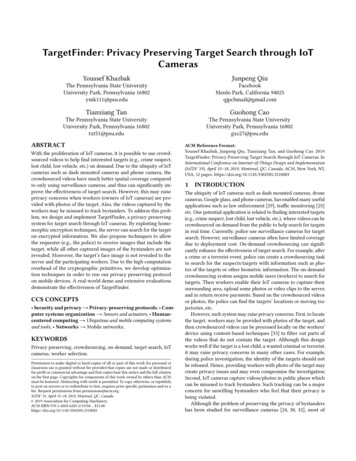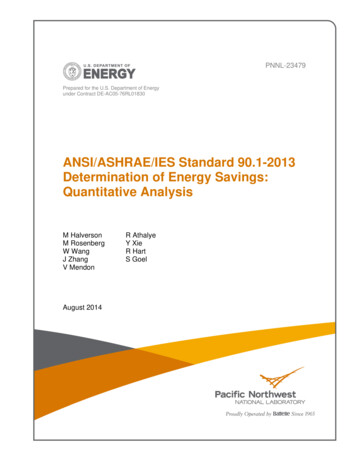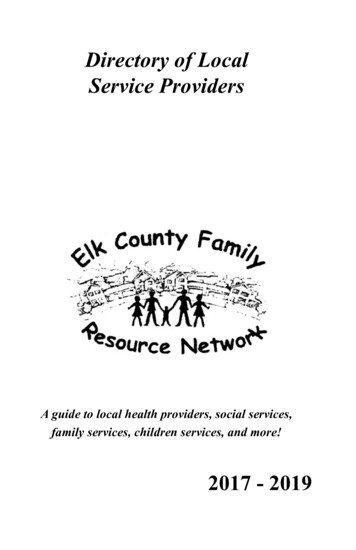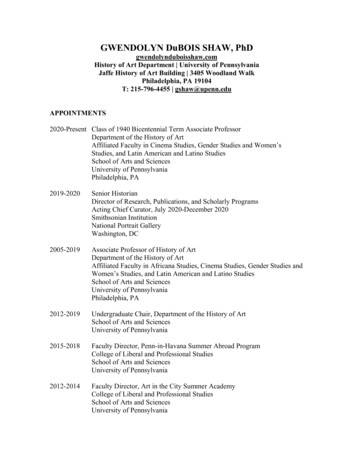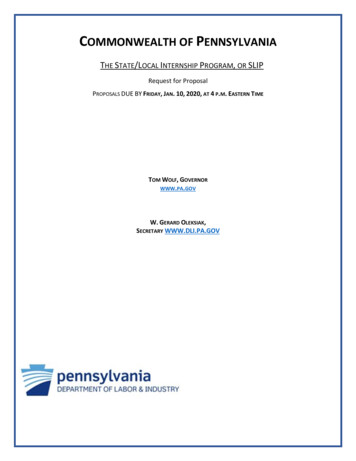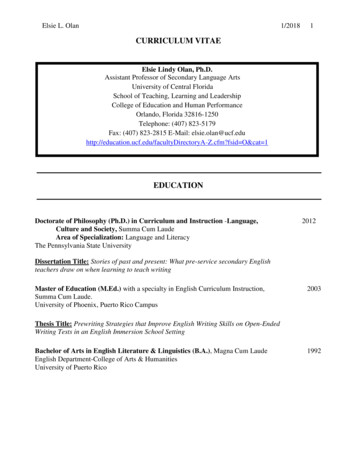
Transcription
5 Capability Assessment5 Capability AssessmentPennsylvania 2018 State Hazard Mitigation Plan569
5 Capability Assessment5. Capability AssessmentUpdate Process SummaryThe purpose of conducting a capability assessment is to determine the ability of theCommonwealth to implement a comprehensive mitigation strategy and to identify potentialopportunities for establishing or enhancing specific mitigation policies, programs, or projects.The capability assessment provides an opportunity to highlight the positive mitigation measuresalready in place or being implemented throughout the Commonwealth, which should continue tobe supported and enhanced if possible through future mitigation efforts.This section provides an assessment of state and local hazard mitigation capabilities andtouches on some of the federal hazard mitigation programs most relevant in Pennsylvania. Atthe state level, a summary of the tools available to the Commonwealth for pre- and post-disasterhazard mitigation efforts is provided as well as development management. Federal, state, localand private funding sources are provided in Section 5.3.3. The State Capability Assessment inthe 2007 SSAHMP focused primarily on the presence of the Commonwealth’s EmergencyOperations Plan. The 2010 SSAHMP expanded the assessment to comprehensively describeother tools available related to hazard mitigation and development in hazard-prone areas. The2013 SSAHMP included the following significant updates and additions: Addition of “Legal Context” sectionAddition of “Federal Programs Supporting Hazard Mitigation in Pennsylvania” sectionUpdates to the BORM staff text such as job descriptions, trainings, conferences,exercises, etc.Updates to the organizational charts for PEMA and BORMAddition of “Other State and Multi-Agency Programs in Pennsylvania” sectionAddition of “Hazard Mitigation Land Use Measures in Pennsylvania” sectionAdditions to the “PA Emergency Operations Center” sectionUpdates to the “Status of Local Hazard Mitigation Plans” section text and mappingUpdates to the “Summary & Evaluation of Local Mitigation Capability” section text andmappingAddition of a CRS, Firewise, and StormReady informationAddition of a more robust program and plan integration sectionThe 2018 update improved and updated information through Section 5. Edits to 5.5 were afocus of the update to improve the information on plan integration and better graphicallyrepresent how it is accomplished in Pennsylvania. Edits were made throughout Section 5 todescribe plans for PEMA and DCED collaboration on NFIP management.A comprehensive list of existing planning policies, programs, and capabilities which supporthazard mitigation activities is included in Section 5.3.1. This assessment was prepared basedon information gathered from the SPT and county staff and through coordination with BORMstaff. Opportunities to review draft information were provided to the SPT, county staff, andothers who attended the public forums. Section 5.2 below provides additional information onfederal, state, and local laws that influence the Commonwealth’s hazard mitigation capability.Pennsylvania 2018 State Hazard Mitigation Plan570
5 Capability AssessmentLegal ContextThe following is a summary of the federal, state, and local disaster mitigation and emergencymanagement laws. Many of these laws are referenced and/or described in more detailthroughout this chapter or in other areas of the plan.5.2.1.Federal LawsPresidential Policy Directive 8 and Related RequirementsThe Threat and Hazard Identification and Risk Assessment (THIRA) is a requirement forHomeland Security Grants and Emergency Management Performance Grants. The StatePreparedness Report (SPR) is a self-assessment of preparedness conducted via astandardized survey and is required by the Post Katrina Emergency Management Reform Act of2006 (PKEMRA). PEMA uses the THIRA and the SPR together to assess threats and hazards,examine the consequences associated with their impact, and select planning and preparednessactivities that build core capabilities among the five mission areas (prevention, protection,mitigation, response, recovery) identified within the National Preparedness Goal (NPG). Theseproducts are all related to the Department of Homeland Security and Presidential PolicyDirective 8: National Preparedness of 2011 (PPD-8), which details the national approach topreparing for threats and hazards posing a national security risk (PEMA, 2018).Robert T. Stafford Disaster Relief and Emergency Assistance ActThe Robert T. Stafford Disaster Relief and Emergency Assistance Act of 1988 authorizestechnical, financial, logistical, and other assistance from the federal government to state andlocal governments during declared major disasters and emergencies.Disaster Mitigation ActThe Disaster Mitigation Act of 2000 amended the Stafford Act and the Public Works Act, whichprovides grants for economic development, to require local governments to prepare hazardmitigation plans as a precondition for receipt of Hazard Mitigation Grant Program project funds.The Disaster Mitigation Act encourages communities to reduce preventable, repetitive disasterlosses by mitigating natural hazards, vulnerability, and risk.National Flood Insurance ActThe National Flood Insurance Act of 1968 established the National Flood Insurance Program(NFIP), which allows residents of participating communities to purchase flood insurance inexchange for the implementation and enforcement by state and local communities of floodplainmanagement ordinances. Over 21,000 communities participate in the NFIP.Biggert-Waters Flood Insurance Reform Act and the Homeowner Flood InsuranceAffordability Act of 2014The Biggert-Waters Flood Insurance Reform Act of 2012 made significant changes to the NFIP.This act requires the NFIP to raise subsidized insurance rates to actuarial rates in an effort tomake the program more financially stable. The Act implemented rate increases for owners ofsubsidized policies on non-primary/secondary residences, to owners of subsidized policies onproperty that has experienced severe or repeated flooding, and on business/non-residentialproperties in a Special Flood Hazard Area. Primary residences in the SFHA would keep theirPennsylvania 2018 State Hazard Mitigation Plan571
5 Capability Assessmentexisting subsidized rates until the property is sold, the policy lapses, a new policy is purchased,or the property suffers severe, repeated flood losses. Grandfathered rates would be phased outat a rate of 20% increase per year for five years when a community adopts a new, updatedFIRM.The Homeowner Flood Insurance Affordability Act of 2014 (HFIAA) addressed criticism of theBiggert-Waters Act by making the transitions to paying more for insurance more gradual. TheHFIAA restored aspects of grandfathering by limiting annual rate increases providing time forproperty owners to mitigate and budget for insurance costs. HFIAA also introduced an annualsurcharge to all policyholders to help support the fiscal soundness of the program.The NFIP Reauthorization is currently in consideration of the US Congress and additionalchanges may be made. The summary for communities and policy holders is that the cost ofinsurance is likely to rise and that the investment in mitigation is likely to see additional benefitsin both safety and savings. In response to these changes, FEMA is encouraging communities toconsider joining the Community Rating System (CRS) or to increase their CRS activities tolower premiums for residents and also to consider pursuing FEMA grants through theCommonwealth. DCED and BORM staff have been educating the public about these importantchanges to the NFIP by addressing flood insurance reform in community trainings.Pandemic and All-Hazards Preparedness ActThe Pandemic and All-Hazard Preparedness Act of 2006 had broad implications for theDepartment of Health and Human Service's’ preparedness and response activities, includingproviding new authorities for programs such as development and acquisition of medicalcountermeasures and the establishment of a quadrennial National Health Security Strategy. Theact was reauthorized in March 2013.Nationwide Programmatic Environmental DocumentsIn order to receive federal funding, projects must comply with the National Environmental PolicyAct (NEPA) of 1969, which requires federal agencies to consider the effects of proposedprojects on the natural and human environment. To eliminate repetitive discussions, nationwideprogrammatic environmental documents have been developed. If a given project meets thescope, impacts, and mitigation covered in the related programmatic environmental document,then no further NEPA documentation will be required. Programmatic environmental documentsrelevant to the Commonwealth of Pennsylvania include (FEMA, 2018): Programmatic Environmental Impact Statement for the NFIP (Final – September 1976) Programmatic Environmental Assessment for Integrated Public Alert and WarningSystem Construction Projects (Final – June 2010) (radio stations) Programmatic Environmental Assessment for the Grant Programs Directorate Programs(Final – July 2010) Programmatic Environmental Assessment for Hazard Mitigation Safe RoomConstruction (Draft – March 2011)Pennsylvania 2018 State Hazard Mitigation Plan572
5 Capability AssessmentAdministrative DirectivesFederal guidelines are in place to assist state and local governments with mitigation,preparedness, response, and recovery programs. Relevant federal guidelines include theNational Incident Management System, which provides standard procedures for incidentcommand; the National Response Framework, which provides response and recoveryguidelines; and the National Disaster Recovery Framework, which provides a recoveryframework.5.2.2.State LawsPennsylvania Flood Plain Management Act (DCED)The Pennsylvania Flood Plain Management Act (Act 166) encourages sound land us practiceswithin the floodplain. The Act requires which municipalities with SFHAs to participate in theNFIP meeting the minimum standards. The Act establishes higher regulatory standards forhazardous materials and high-risk land uses and currently designates DCED as the State NFIPCoordinator.PEMA and DCED have established a new partnership to manage the NFIP in Pennsylvania.Now both agencies and specifically BORM within PEMA will support the NFIP responsibilitiesfor the Commonwealth. As this partnership continues and grows the agency location of theState NFIP Coordinator may change if it is determined that NFIP management in theCommonwealth would be improved by amendments to Act 166.Pennsylvania Emergency Management Service Code, Title 35Pennsylvania’s Emergency Management Service Code, Title 35, covers PEMA’s overall legalresponsibilities for emergency management. PA CS Title 35 Section 7102 defines emergencymanagement as “the judicious planning, assignment and coordination of all available resourcesin an integrated program of prevention, mitigation, preparedness, response and recovery foremergencies of any kind, whether from attack, manmade or natural sources.” Section 7311establishes that PEMA was created “to assure prompt, proper and effective discharge of basicCommonwealth responsibilities relating to civil defense and disaster preparedness, operationsand recovery.” Title 35 addresses PEMA’s responsibilities before, during, and after disaster.Pennsylvania Hazardous Material Emergency Planning and Response Act (DEP, PEMA,PA DLI, and Local Emergency Planning Committees, or LEPCs)The Superfund Amendments and Reauthorization Act 165 of 1986 and amended in 2011(SARA) combats only one specific type of disaster - hazardous materials. The law has severalprovisions, including requirements for reporting releases of chemicals and requirements for theprotection of responders. However, SARA Title III (i.e. the Federal Emergency Planning andCommunity Right-to-Know Act), relating to emergency planning and community right-to-know,has the greatest impact on local governments.SARA Title III requires every facility, public or private, that routinely has on-hand more than athreshold quantity of certain acutely hazardous chemicals to report the name, amount, andlocation of the chemical to the county, state, and federal environmental protection agencies.This includes many municipal swimming pools, waste treatment plants, and most industrialPennsylvania 2018 State Hazard Mitigation Plan573
5 Capability Assessmentfacilities in the Commonwealth. It then requires facilities to develop an on-site emergencyresponse plan. The key groups in these emergency response plans are the local emergencyplanning committees (LEPCs), appointed to receive the information from facilities and developan off-site emergency plan for every facility which reported having threshold quantities ofextremely hazardous substances. These LEPCs must include elected officials; fire, police, civildefense, and public health professionals; environmental, hospital, and transportation officials, aswell as representatives of the facilities, community groups, and the media. The LEPC evaluatesavailable resources for preparing for and responding to a potential chemical accident, providingan essential pre-disaster capability to communities that host SARA Title III facilities.These federal requirements are implemented at the state level through Act 165 (i.e.Pennsylvania Hazardous Material Emergency Planning and Response Act, 1990-165). Act 165creates a strong working relationship between business and industry, the Commonwealth,counties, and local municipalities to protect citizens from the dangers of hazardous materials.The history of the program indicates that the interest of elected officials who participate onLEPCs is effective.PEMA estimates that there are more than 3,200 SARA facilities throughout the Commonwealthwith 97% of these facilities having emergency plans in place that have been reviewed by PEMAand were found to adequately provide for the health and safety of public and the environment(PEMA, 2018)Pennsylvania Radiation Protection Act (PEMA and DEP, Bureau of Radiation Protection)Act 147 (i.e. Pennsylvania Radiation Protection Act, 1984-147) deals specifically with radiation,control of radioactive sources, and accidental releases of radiation from any of the nuclearpowered electric generating facilities in Pennsylvania. The act was most recently amended in2007 with Act 31. This law empowers the DEP to implement a comprehensive statewideradiation protection program, and also enables PEMA to develop a radiological emergencyresponse program with plans for each fixed nuclear power generating facility. In implementingthe radiological emergency response program, PEMA has planned for evacuation or protectionof persons in the area immediately surrounding a given facility with a ten-mile radius. Each ofthe affected municipalities has a plan that addresses accidental releases of radiation at thefacility. The law requires periodic exercise of these plans; every two years there is a full-scaleexercise involving several hundred people to test the plan and response capabilities.Act 147 also created a Radiation Emergency Response Fund and a Radiation TransportationEmergency Response Fund, which receives money from nuclear facility operators, spent fuelstorage facilities, and spent nuclear fuel shippers. PEMA then distributes this money to affectedcounties where it is then distributed to municipalities. Funds are distributed based on grantapplications submitted by counties to reimburse expenses involved in preparing plans, providingequipment, and involved in training and exercising the radiological emergency responseprogram.Pennsylvania 2018 State Hazard Mitigation Plan574
5 Capability AssessmentCounterterrorism Planning, Preparedness and Response Act (PEMA, OHS, PSP, andDOH)Act 227 (i.e. the Counterterrorism Planning, Preparedness and Response Act of December 16,2002, P.L. 1967, No. 227 35) provides for counterterrorism planning, preparedness, andresponse; imposing powers and duties on PEMA, DOH, counties, and municipalities; andproviding for the organization of various response teams. Act 227 states the responsibilities ofregional counter-terrorism task force groups, the urban search and rescue task force, andspecialized response teams, and also provides immunity from liability.Public Safety Emergency Telephone Act (PEMA and PUC)Act 78 (i.e. the Public Safety Emergency Telephone Act, 1990-78), as amended, is designed toprovide a toll-free standard number (911) accessible from both land and cellular phones for anyindividual in the Commonwealth to gain rapid, direct access to emergency services. The actwas amended in 1998 with Act 17. The act places responsibility for developing a 911 system oncounty government. The act also allows for end-user contributions based on the number oflines of telephone service. Act 78 establishes technical, training, and certification guidelinesand minimum standards to be met in developing the county 911 system. Additionally, the actencourages the development of enhanced 911 systems and constant improvement of existingsystems.Pennsylvania Construction Code Act (Department of Labor & Industry and Office of theFire Commissioner)The Pennsylvania Construction Code Act (Act 45) of 1999 (as amended) establishes the basicrequirements for the Uniform Construction Code (UCC), which applies to the construction,alteration, repair, demolition, or change of occupancy of buildings. Utilization of the UCCprovides for the protection of life, health, property, and the environment on a daily basis as wellas during disasters by establishing construction standards. Pennsylvania is protected by theguidelines set forth in the UCC, with the majority of municipalities administering compliancelocally (DLI, 2018).Storm Water Management Act (DEP)The Storm Water Management Act (Act 167) was enacted in 1978 to counter the effects of landdevelopment on storm water runoff. Act 167 requires all counties in Pennsylvania to prepareand adopt watershed-based storm water management plans and requires municipalities toadopt and implement ordinances to regulate development in a way which is consistent with thelocal Act 167 plan.Marcellus Shale Drilling Regulations (DEP, Bureau of Oil and Gas Management)The Bureau of Oil and Gas Management in the Pennsylvania Department of EnvironmentalProtection along with county conservation districts and either the Susquehanna River BasinCommission or the Delaware River Basin Commission have authority to regulate the oil and gasindustry in Pennsylvania to protect the environment and citizens of the Commonwealth. Permitsand bonds must be provided at various stages including prior to pad construction, pipelineconstruction, drilling of the well, withdrawal or disposal of water, and impoundment of water. Oiland gas exploration in Pennsylvania is regulated through the Oil and Gas Act, the Coal and GasPennsylvania 2018 State Hazard Mitigation Plan575
5 Capability AssessmentResource Coordination Act, the Oil and Gas Conservation Law, the Clean Streams Law, theDam Safety and Encroachments Act, the Solid Waste Management Act, and the WaterResources Planning Act (PA House of Representatives, unknown publication date).The Oil and Gas Act (Act 13 of 2012) presented major changes to the oil and gas industry inPennsylvania, including the authorization for local governments to adopt an impact fee and theprovision of stronger environmental protections. For example, oil and gas well pad setbacksfrom private water wells, streams, and buildings increased; bond amounts for catastrophicaccidents increased; and public accessibility of information related to chemicals used onsiteimproved (Pittsburg Post-Gazette, 2012). 60% of the revenue stays at the local level, going tocounties and municipalities hosting wells. The rest goes to various state agencies involved inregulating drilling and to the Marcellus Legacy Fund, which gets distributed to the state forenvironmental and infrastructure projects (PA PUC, 2012).Local governments can use their shares of the funds on various expenses related to natural gasdevelopment, including: Construction, repair and maintenance of roads, bridges and other public infrastructureWater, storm water, and sewer system construction and repairEmergency response preparedness, training, equipment, responder recruitmentPreservation and reclamation of surface and subsurface water suppliesRecords management, geographic information systems and information technologyProjects which increase the availability of affordable housing to low-income residentsDelivery of social services, including domestic relations, drug and alcohol treatment, jobtraining and counselingOffsetting increased judicial system costs, including trainingAssistance to county conservation districts for inspection, oversight and enforcement ofnatural gas developmentCounty or municipal planningOther statewide initiatives that can be funded with impact fee funds are: 5.2.3.Acid mine drainage, abatement and cleanupOrphaned or abandoned oil and gas well pluggingCompliance with PA Sewage Facilities ActPlanning, Acquisition, development and repair of greenways, recreational trails, openspace, parks and beautification projectsPrograms to establish baseline water quality data on private water suppliesWatershed programs and related projectsUp to 25% of funds for flood control projectLocal OrdinancesIt is important to note that Pennsylvania adopted Home Rule Law in 1972. Home Rule impactshow municipal governments interact with the county and state government. With Home Rule,municipalities have the authority to exercise governance in any area not specifically limited byPennsylvania 2018 State Hazard Mitigation Plan576
5 Capability Assessmentstate law, rather than in a non-Home Rule state where municipalities act only where specified bystate law. An example of where Pennsylvania state law does set requirements for municipalitiesis the Municipal Planning Code.Pennsylvania Municipalities Planning Code Act (DCED)Per the Pennsylvania Municipalities Planning Code Act, P.L. 805, No. 247 (Act 247) of 1968,boroughs, townships, and counties have the authority to individually or jointly prepare zoning,subdivision, land development, floodplain management, and other ordinances, as well as officialzoning maps, all of which can be used as tools to guide growth and minimize development inhazard prone areas. Act 247 also requires counties to create and adopt a comprehensive planand encourages municipalities to adopt municipal or joint municipal comprehensive plansgenerally consistent with the county comprehensive plan.5.3.1.State Capability AssessmentPre-disaster CapabilityFederal capability for some agencies is listed in the state capability section to illustrate how theCommonwealth is leveraging federal programs to increase state capability.5.3.1.1.Federal Programs Supporting Hazard Mitigation in PennsylvaniaThere are a number of federal programs that support hazard mitigation in Pennsylvania from avariety of agencies and entities. This section provides a summary of the most relevant federalagency programs that directly support PEMA and FEMA’s hazard mitigation efforts.United States Geological SurveyThe United States Geological Survey works with the National Weather Service, the USACE, andFEMA through the Flood Inundation Mapping Program(https://water.usgs.gov/osw/flood inundation/) to help communities understand flood risks andmake cost-effective mitigation decisions. The flood inundation library contains a series of mapswhich illustrate where flooding will occur at various river levels, and during a flood event thesemaps can be combined with real-time USGS streamflow data and NWS flood forecasts toprovide real-time and forecasted mapping. These maps can be used for preparedness,mitigation, and planning; environmental and ecological assessments; timely response; andrecovery.The USGS also provides flood-related information through the following programs andresources: WaterAlert service (http://water.usgs.gov/wateralert)WaterWatch (http://waterwatch.usgs.gov)WaterNow (http://water.usgs.gov/waternow)StreamStats (http://streamstats.usgs.gov)USGS Flood Information (http://water.usgs.gov/flood)Additionally, the USGS provides data to the Department of Environmental Protection for droughtdeterminations, participates in the Emergency Operations Center calls when needed,Pennsylvania 2018 State Hazard Mitigation Plan577
5 Capability Assessmentcoordinates with FEMA following an event to document the effects, and has a Continuity ofOperations plan in place.United States Army Corps of EngineersThe USACE, in addition to their leadership role in the Silver Jackets, plays a role in flood riskmanagement as well as dam and levee safety, planning, engineering, and emergencymanagement. The USACE partners with the Department of Environmental Protection for annuallevee safety workshops and conducts table-top drills with partners.United States General Services AdministrationThe United States General Services Administration’s (GSA) role in hazard mitigation anddisaster response is to support state and local governments in supply and logistics by trainingusers in the use of GSA’s e-tools for product and service contracting coverage, pricing, andrequests for quotes. Additionally, GSA staff practice table-top drills.Office of Infrastructure ProtectionThe DHS Office of Infrastructure Protection serves a key role in hazard mitigation. ProtectiveSecurity Advisors serve as liaisons among DHS and other federal agencies, state and localgovernments, and the private sector on security compliance/enforcement matters related to theprotection of critical infrastructure and assets. There are three Protective Security Advisorsassigned to Pennsylvania in Pittsburgh, Harrisburg, and Philadelphia, and the regional directoris also located in Philadelphia. These Protective Security Advisors meet with site securitypersonnel to review protection plans and identify requirements for protection support; monitorinformation on threats; develop and implement local policies; coordinate requests for federaltraining and assistance; and conduct workshops, forums, and conferences. This office works toidentify and prioritize assets, conduct assessments in support of special events, conduct threatbased outreach, serve in emergency operations centers and joint field offices, andconduct/assist in Office of Bombing Prevention improvised explosive device threat and riskmitigation training. Trainings facilitated by Protective Security Advisors include the IEDAwareness/Bomb Threat Management Workshop, the IED Search Procedures Workshop, theProtective Measures Course, the Surveillance Detection Course for Law Enforcement &Security Professionals, the IED Counterterrorism Workshop, the Counter-IED/Bomb ThreatManagement Workshop, Active Shooter Training, Workplace Violence Incidents Training, SoftTarget Awareness, and the Bomb Making Awareness Program. These trainings serve privatesector owners and operators as well as first responders and emergency managementpersonnel.5.3.1.2.Pennsylvania Emergency Management AgencyPEMA Pre-disaster Capability OverviewPennsylvania’s Emergency Management Service Code, Title 35, addresses PEMA’sresponsibilities before, during, and after disaster. Mitigation is managed through the BORM,which capably provides and participates in hazard mitigation and disaster trainings, disasterexercises, and conferences. BORM staff support the identification and implementation ofpotential mitigation projects, and also provide various tools and technical assistance for localagencies on PEMA’s Hazard Mitigation webpage and in-person. RL and SRL propertyPennsylvania 2018 State Hazard Mitigation Plan578
5 Capability Assessmentmitigation is consistently prioritized in pre- and post-disaster efforts. The readiness for disasteris maintained by adhering to the Pennsylvania State Emergency Operations Plan and bymaintaining EMAP accreditation.PEMA’s outreach and citizen engagement efforts are also a key component of the agency’s predisaster capability. The primary components of these efforts are ReadyPA, Citizen Corps, andthe Community Emergency Response Team (CERT) program. As a program, ReadyPA is a toolused by Citizen Corps and CERT, as well as government and non-profit organizations to assistPennsylvania citizens in preparing for disaster. Citizen Corps was created to help coordinatevolunteer activities that will make our communities safer, stronger, and better prepared torespond to any emergency situation. It provides opportunities for people to participate in a rangeof measures to make their families, their homes, and their communities safer from the threats ofcrime, terrorism, and disasters of all kinds. Citizen Corps is coordinated nationally by FEMA. Inthis capacity, FEMA works closely with other federal entities, state and local governments, firstresponders, emergency managers, the volunteer community, and the Corporation for National &Community Service.The overall goal of the various projects undertaken and funded through the Citizen Corps GrantProgram is to ensure that the residents of the Commonwealth are prepared at home, school,work, and when they travel throughout the state. In 2008, Pennsylvania kicked off the ReadyPACampaign urging all Pennsylvanians to “Be Informed. Be Prepared. Be Involved.” The fundsspent to date are being used to build private/public partnerships and use those partnerships toreach as many residents as possible as they go about their daily lives. PEMA has leveragedpartnerships during National Preparedness Month to distribute information and to hand outmaterials at PETCO, Home Depot, Lowes, and most recently Target.PEMA has distributed ReadyPA/Pennsylvania Citizen Corps bookmarks to almost 2,000Pennsylvania libraries; and prepar
management staff provides an opportunity for BORM to brief on hazard mitigation. For example in Spring 2018 BORM presented on the State Hazard Mitigation Plan, State Pre-Disaster Recovery Plan and the Integration between the two planning topics. Silver Jackets Non-Structural Flood Proofing Workshops: This workshop for public
